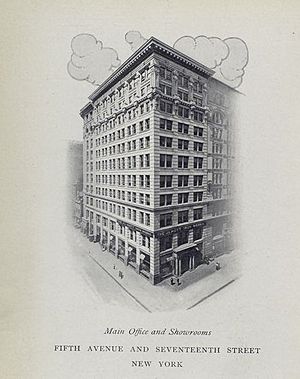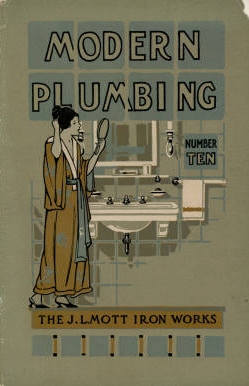J. L. Mott Iron Works facts for kids
The J. L. Mott Iron Works was a famous American company. It made and sold many metal products in the late 1800s and early 1900s. The company started in New York City and later moved to Trenton, New Jersey. It stopped working in the 1920s.
Contents
History of J. L. Mott Iron Works
How the Company Started
The J. L. Mott Iron Works began in 1828. It was started by Jordan L. Mott in New York City. This area is now known as Mott Haven. Before this, Mott was a grocer, which means he sold food.
Jordan L. Mott became interested in working with iron. He invented the first stoves made of cast iron that could burn a special type of coal called anthracite. This invention helped the company grow.
What the Company Made
The J. L. Mott Iron Works made many different things. They sold stoves, furnaces, and items for fireplaces. They also made large pots and kettles.
The company created beautiful metal art, too. This included statues, candle holders, and fountains. They also made garden seats and vases. The company even produced different kinds of iron pipes and water tanks.
Jordan L. Mott was very interested in new inventions. He liked to get patents for his ideas. A patent protects an invention so others can't copy it. He was even offered a job by President Buchanan to be in charge of patents, but he said no.
The Company Grows
Jordan L. Mott's son, J.L. Mott, Jr., took over the business. The J. L. Mott Iron Works had a huge store in New York City. It was 11 floors tall!
The first few floors showed off plumbing and bathroom items. This included special bathtubs made of enameled cast iron. The higher floors had departments for hospitals, ships, and tiles. There were also sections for heating and decorative metal items.
Famous Creations
In 1876, the company showed a large, beautiful fountain at the Centennial Exposition in Philadelphia. This fountain was 25 feet tall. It was made of cast iron.
Artists at the company designed all parts of the fountain. They molded figures in clay first. Then, they used these molds to cast the iron. The bottom part of the fountain was ten feet wide. It was the largest cast-iron basin in the United States at that time.
The company also sold many copies of a famous statue called The Boy with the Leaking Boot. You can still see these statues in cities across America and Canada.
Moving and Modern Art
Around 1902, the company moved its main operations. It went from New York City to Trenton, New Jersey.
In 1917, a famous artist named Marcel Duchamp may have used a urinal from a J.L. Mott showroom. He showed it as a work of art called Fountain. This event was important in modern art history. It introduced the idea of "readymades." A readymade is an everyday object presented as art.
A Different Company
There is a company called Mott Iron Works that started in Massachusetts in 1984. However, this newer company has no connection to the original J. L. Mott Iron Works.
See also
- Monumental Bronze Company
- J. W. Fiske & Company
- Scanlan Fountain




